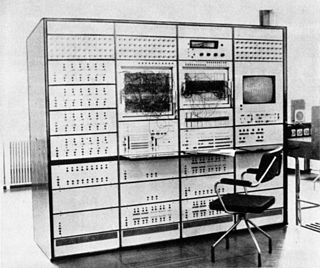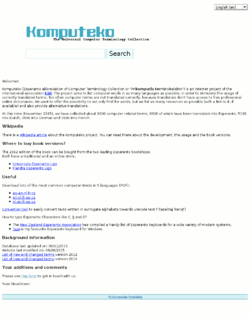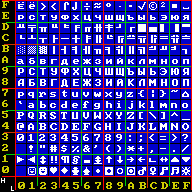 W
WControl logic is a key part of a software program that controls the operations of the program. The control logic responds to commands from the user, and it also acts on its own to perform automated tasks that have been structured into the program.
 W
WCyberwarfare is the use of digital attacks to attack a nation, causing comparable harm to actual warfare and/or disrupting the vital computer systems. There is significant debate among experts regarding the definition of cyberwarfare, and even if such a thing exists. One view is that the term "cyberwarfare" is a misnomer, since no offensive cyber actions to date could be described as "war". An alternative view is that "cyberwarfare" is a suitable label for cyber attacks which cause physical damage to people and objects in the real world.
 W
WA dashboard is a type of graphical user interface which often provides at-a-glance views of key performance indicators (KPIs) relevant to a particular objective or business process. In other usage, "dashboard" is another name for "progress report" or "report" and considered a form of data visualization.
 W
WA digital audio workstation (DAW) is an electronic device or application software used for recording, editing and producing audio files. DAWs come in a wide variety of configurations from a single software program on a laptop, to an integrated stand-alone unit, all the way to a highly complex configuration of numerous components controlled by a central computer. Regardless of configuration, modern DAWs have a central interface that allows the user to alter and mix multiple recordings and tracks into a final produced piece.
 W
WEmbedded software is computer software, written to control machines or devices that are not typically thought of as computers, commonly known as embedded systems. It is typically specialized for the particular hardware that it runs on and has time and memory constraints. This term is sometimes used interchangeably with firmware.
 W
WIn product development, an end user is a person who ultimately uses or is intended to ultimately use a product. The end user stands in contrast to users who support or maintain the product, such as sysops, system administrators, database administrators, information technology experts, software professionals and computer technicians. End users typically do not possess the technical understanding or skill of the product designers, a fact easily overlooked and forgotten by designers: leading to features creating low customer satisfaction. In information technology, end users are not "customers" in the usual sense—they are typically employees of the customer. For example, if a large retail corporation buys a software package for its employees to use, even though the large retail corporation was the "customer" which purchased the software, the end users are the employees of the company, who will use the software at work.
 W
WFuture-proofing is the process of anticipating the future and developing methods of minimizing the effects of shocks and stresses of future events. Future-proofing is used in industries such as electronics, medical industry, industrial design, and more recently, in design for climate change. The principles of future-proofing are extracted from other industries and codified as a system for approaching an intervention in an historic building.
 W
WHybrid computers are computers that exhibit features of analog computers and digital computers. The digital component normally serves as the controller and provides logical and numerical operations, while the analog component often serves as a solver of differential equations and other mathematically complex equations. The first desktop hybrid computing system was the Hycomp 250, released by Packard Bell in 1961. Another early example was the HYDAC 2400, an integrated hybrid computer released by EAI in 1963. In the 1980s, Marconi Space and Defense Systems Limited developed their "Starglow Hybrid Computer", which consisted of three EAI 8812 analog computers linked to an EAI 8100 digital computer, the latter also being linked to an SEL 3200 digital computer. Late in the 20th century, hybrids dwindled with the increasing capabilities of digital computers including digital signal processors.
 W
WKomputeko is an online project of the non-profit youth organization E@I (“Education@Internet”) with the goal of bringing together parallel computer terminology from various dictionaries in order to facilitate access to and comparison between different translations and thus promote exact use of language and counteract the usage of linguistic borrowings from American English. Komputeko is short for the Esperanto noun phrase "Prikomputila terminokolekto", meaning "collection of computer terms". The dictionary is written in five languages, and there are plans to expand it into other languages. A preliminary version with a few other languages already exists.
 W
WIn communications and computing a machine-readable medium, or computer-readable medium, is a medium capable of storing data in a format readable by a mechanical device.
 W
WMap matching is the problem of how to match recorded geographic coordinates to a logical model of the real world, typically using some form of Geographic Information System. The most common approach is to take recorded, serial location points and relate them to edges in an existing street graph (network), usually in a sorted list representing the travel of a user or vehicle. Matching observations to a logical model in this way has applications in satellites navigation, GPS tracking of freight, and transportation engineering.
 W
WIn computing, a nibble (occasionally nybble or nyble to match the spelling of byte) is a four-bit aggregation, or half an octet. It is also known as half-byte or tetrade. In a networking or telecommunication context, the nibble is often called a semi-octet, quadbit, or quartet. A nibble has sixteen (24) possible values. A nibble can be represented by a single hexadecimal digit (0–F) and called a hex digit.
 W
WIn computing, rename refers to the altering of a name of a file. This can be done manually by using a shell command such as ren or mv, or by using batch renaming software that can automate the renaming process.
 W
WIn systems engineering, information systems and software engineering, the systems development life cycle (SDLC), also referred to as the application development life-cycle, is a process for planning, creating, testing, and deploying an information system. The systems development life cycle concept applies to a range of hardware and software configurations, as a system can be composed of hardware only, software only, or a combination of both. There are usually six stages in this cycle: requirement analysis, design, development and testing, implementation, documentation, and evaluation.
 W
WIn computing, a task is a unit of execution or a unit of work. The term is ambiguous; precise alternative terms include process, light-weight process, thread, step, request, or query. In the adjacent diagram, there are queues of incoming work to do and outgoing completed work, and a thread pool of threads to perform this work. Either the work units themselves or the threads that perform the work can be referred to as "tasks", and these can be referred to respectively as requests/responses/threads, incoming tasks/completed tasks/threads, or requests/responses/tasks.
 W
WUnclick is a term, increasingly applied in the context of computing, in which a computer user un-chooses or de-selects a specific preference, typically by moving a cursor over a selection, and pressing the left mouse button. As a result, the check mark image or dark circle inside a checkbox or a radio button is removed. While in January 2012 the term unclick is generally not formally defined in dictionaries, the term has been used in popular parlance in countries such as the United States, Britain, and Canada.
 W
WA user is a person who utilizes a computer or network service.
 W
WA word processor (WP) is a device or computer program that provides for input, editing, formatting, and output of text, often with some additional features.
 W
WA word processor is an electronic device for text, composing, editing, formatting, and printing.